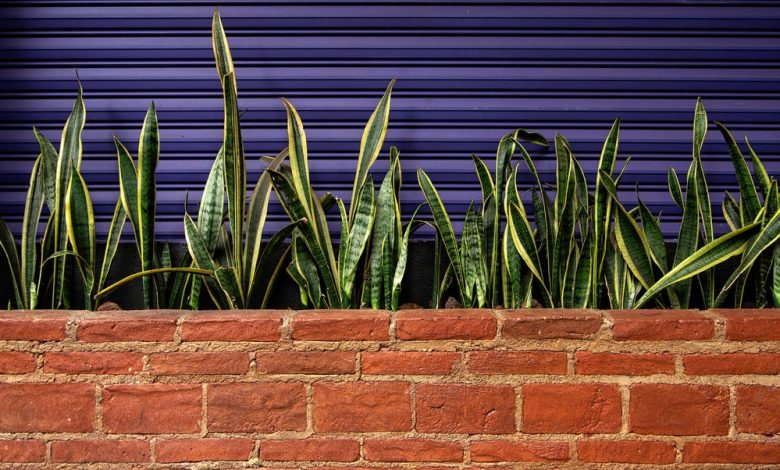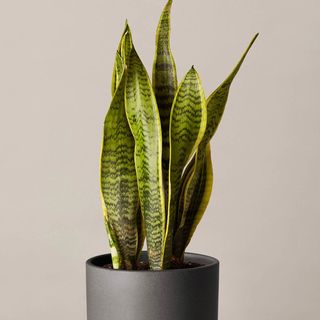How to Grow & Maintain Sansevieria Varieties

[ad_1]
ANASTASIIA DMITRIEVAGetty Images
When it comes to choosing a hard-to-kill houseplant, you’d be hard-pressed to find a better option than the snake plant. Also known as dracaena trifasciata, sansevieria trifasciata or mother-in-law’s tongue, snake plants are native to tropical West Africa. Because they store water in their leaves, they’re virtually indestructible. These popular, low-maintenance plants grow slowly and, depending on the variety, can reach anywhere from eight inches to 12 feet with proper care.
Snake plants are marked by narrow, upright leaves with striking white and yellow stripes, making them a no-fail option for enlivening your home or office. Allergy sufferers will appreciate the snake plant’s air-purifying qualities: They’re particularly great for bedrooms, as they produce oxygen at night. In certain cultures, snake plants represent good luck and positivity — but best of all, they can survive for a decade or more with very little care required. Oh, and they’re pretty inexpensive! Read on for everything you need to know about snake plants, including how much sunlight and water they need to thrive.
⚠️ Take note: This plant is toxic to cats and dogs.
Types of Snake Plants
Believe it or not, there are more than 70 different species of the snake plant. Just a few examples that you might consider are:
- Sansevieria Black Gold: You might have spotted this variety at your local garden center. It features dark green, lance-shaped leaves with golden margins.
- Sansevieria Gracilis: This snake plant is smaller in stature; leaves don’t tend to grow more than 18 inches in height. They can produce fragrant white flowers.
- Bird’s Nest Sansevieria (Golden Hahnii): This small succulent only grows between six and eight inches tall. It features oval-shaped leaves with a gray-green hue and buttery yellow margins.
- Dracaena Trifasciata (Moonshine): This drought-tolerant plant has spear-like, silvery-green leaves with deep green margins.
- Sansevieria Cylindrica Boncel (Starfish Sansevieria): This snake plant features a distinct fan shape with light green leaves covered in dark green rings. Its leaves can reach up to seven feet, and you might even notice small white flowers if they’re grown in full sun.
Snake Plant Care Tips
If you’re new to taking care of plants, snake plants are a great choice since they can handle a lot of neglect. They’re great indoor container plants, but you can also grow snake plants outdoors in warm climates.
Sunlight
While bright, indirect sunlight is the ideal environment for snake plants, they are able to tolerate a range of other extreme conditions, whether it’s a room with full sun or a dark corner. Be sure to regularly dust the plant’s leaves with a damp cloth to improve its ability to photosynthesize.
Water
This indestructible plant has broad leaves that can retain water well. For this reason, it should only be watered when the soil is almost dry, which can be every two to eight weeks. Keep in mind that it’s not necessary to mist the leaves.
Soil
Snake plants are susceptible to root rot, so aim for well-drained soil. Opt for a commercial potting mix intended for succulents or cacti.
Common Problems With Snake Plants to Avoid
✔️ Overwatering: If your plant’s leaves are bent or dropping, chances are you’ve been overwatering it. Avoid this to make sure its roots remain firm; they should never be drenched in water for a long period of time.
✔️ Extremely Cold Temperatures: Overly cold temperatures can lead to leaves that appear yellow, scarred or even mushy. Prune damaged leaves to allow the healthy ones to flourish without any issues.
✔️ Pest Infestation: Common household plants, like the snake plant, tend to attract mealybugs. A sign that they might have infected your plant is if leaves begin to have white spots or show other signs of deformation.
✔️ Pets: Pet lovers, beware. Snake plants contain saponins, which are toxic to cats and dogs. (And if the leaves are accidentally ingested, they can cause gastrointestinal problems in humans, too).
The bottom line: Snake plants are a great choice if you’re searching for no-stress greenery to enliven your home. Master these basic care tips for snake plants and they can easily fill your space with beauty and fresh, healthy air.
This content is created and maintained by a third party, and imported onto this page to help users provide their email addresses. You may be able to find more information about this and similar content at piano.io
[ad_2]
Source link











